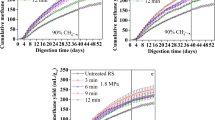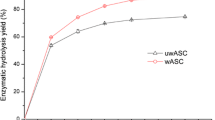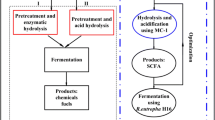Abstract
Effective pretreatment process to improve enzymatic saccharification and decrease inhibitors generation is a key operation involved in the lignocellulosic bioconversion. The pretreatment of steam explosion associated with ammonium sulfite (SEAS) process was carried out to investigate the effect on enzymatic hydrolysis and fermentation production as a combinatorial pretreatment. Results showed that after pretreatment (1.0 MPa, 30 min, 20%w/w ammonium sulfite added), the phenolic inhibitors derived from lignin significantly removed (37.8%), which transformed to chemical humic acid (humic acid and fulvic acid) mostly. Sugar conversion (glucan (77.8%) and xylan (73.3%)) and ethanol concentration (40.8 g/L) of combinatorial pretreated samples were increased by 24.7% and 33.8%, respectively, compared with steam explosion (SE) pretreated samples. FT-IR and elemental analysis results indicated that the lignin structure changed and aromatization degree increased after SEAS pretreatment. In addition, the ratio of C/N decreased and compost maturity degree increased with the holding time. The effect on the growth of wheat seedlings of soluble fulvic acid solution from combinatorial pretreatment was investigated, where below 1% (w/w) concentration did contribute to growth. Therefore, one-step chemical pretreatment process could be provided for inhibitors removal, enzymatic saccharification increase, and chemical humic acid formation as well.




Similar content being viewed by others
References
Jönsson, L. J., & Martín, C. (2016). Pretreatment of lignocellulose: formation of inhibitory by-products and strategies for minimizing their effects. Bioresource Technology, 199, 103–112.
Arevalo-Gallegos, A., Ahmad, Z., Asgher, M., Parra-Saldivar, R., & Iqbal, H. M. (2017). Lignocellulose: a sustainable material to produce value-added products with a zero waste approach—a review. International Journal of Biological Macromolecules, 99, 308–318.
Chen, H., Liu, J., Chang, X., Chen, D., Xue, Y., Liu, P., Lin, H. L., & Han, S. (2017). A review on the pretreatment of lignocellulose for high-value chemicals. Fuel Processing Technology, 160, 196–206.
Sindhu, R., Binod, P., & Pandey, A. (2016). Biological pretreatment of lignocellulosic biomass—an overview. Bioresource Technology, 199, 76–82.
Chen, H. Z. (2015). Gas explosion technology and biomass refinery. Netherlands: Springer.
de Souza Moretti, M. M., Perrone, O. M., Nunes, C. D. C. C., Taboga, S., Boscolo, M., da Silva, R., & Gomes, E. (2016). Effect of pretreatment and enzymatic hydrolysis on the physical-chemical composition and morphologic structure of sugarcane bagasse and sugarcane straw. Bioresource Technology, 219(219), 773–777.
Chen, H. (2015). Lignocellulose biorefinery engineering: principles and applications (No. 74). Woodhead Publishing.
Chen, H., & Wang, L. (2016). Technologies for biochemical conversion of biomass. Academic Press.
Grous, W. R., Converse, A. O., & Grethlein, H. E. (1986). Effect of steam explosion pretreatment on pore size and enzymatic hydrolysis of poplar. Enzyme and Microbial Technology, 8(5), 274–280.
Brownell, H. H., Yu, E. K. C., & Saddler, J. N. (1986). Steam-explosion pretreatment of wood: effect of chip size, acid, moisture content and pressure drop. Biotechnology and Bioengineering, 28(6), 792–801.
Hull, W., Smith, B., Hull, J., & Holzer, W. (1954). Staff-industry collaborative report ammonia base sulfite pulping. Industrial and Engineering Chemistry, 46(8), 1546–1557.
Qiu, W., & Chen, H. Z. (2012). Enhanced the enzymatic hydrolysis efficiency of wheat straw after combined steam explosion and laccase pretreatment. Bioresource Technology, 118(4), 8–12.
Palmqvist, E., & Hahn-Hägerdal, B. (2000). Fermentation of lignocellulosic hydrolysates. II: inhibitors and mechanisms of inhibition. Bioresource Technology, 74(1), 25–33.
Jönsson, L. J., Alriksson, B., & Nilvebrant, N. O. (2013). Bioconversion of lignocellulose: inhibitors and detoxification. Biotechnology for Biofuels, 6(1), 16.
Han, X., Liu, G., Song, W., Qin, Y., & Qu, Y. (2017). Continuous feeding of spent ammonium sulphite liquor improves the production and saccharification performance of cellulase by Penicillium oxalicum. Bioresource Technology, 245, 984–992.
Alriksson, B., Cavka, A., & Jönsson, L. J. (2011). Improving the fermentability of enzymatic hydrolysates of lignocellulose through chemical in-situ detoxification with reducing agents. Bioresource Technology, 102(2), 1254–1263.
Cavka, A., Alriksson, B., Ahnlund, M., & Jönsson, L. J. (2011). Effect of sulfur oxyanions on lignocellulose-derived fermentation inhibitors. Biotechnology and Bioengineering, 108(11), 2592–2599.
Cavka, A., & Jönsson, L. J. (2013). Detoxification of lignocellulosic hydrolysates using sodium borohydride. Bioresource Technology, 136, 368–376.
Zhang, H., Bai, Y., Zhou, W., & Chen, F. (2017). Color reduction of sulfonated eucalyptus kraft lignin. International Journal of Biological Macromolecules, 97, 201–208.
Qi, G., Xiong, L., Tian, L., Luo, M., Chen, X., Huang, C., Li, H. L., & Chen, X. (2018). Ammonium sulfite pretreatment of wheat straw for efficient enzymatic saccharification. Sustainable Energy Technologies and Assessments, 29, 12–18.
Wu, H., Lai, C., Zeng, G., Liang, J., Chen, J., Xu, J., Dai, J. J., Li, X. D., Liu, J. F., Chen, M., Lu, L. H., Hu, L., & Wan, J. (2017). The interactions of composting and biochar and their implications for soil amendment and pollution remediation: a review. Critical Reviews in Biotechnology, 37(6), 754–764.
de Melo, B. A. G., Motta, F. L., & Santana, M. H. A. (2016). Humic acids: structural properties and multiple functionalities for novel technological developments. Materials Science and Engineering: C, 62, 967–974.
Haider, K., & Martin, J. P. (1967). Synthesis and transformation of phenolic compounds by Epicoccum nigrum in relation to humic acid formation 1. Soil Science Society of America Journal, 31(6), 766–772.
Lipczynska-Kochany, E. (2018). Humic substances, their microbial interactions and effects on biological transformations of organic pollutants in water and soil: a review. Chemosphere, 202, 420–437.
Qiu, W., Zhang, W., & Chen, H. (2014). Natural laccase mediators separated from water-washed solution of steam exploded corn straw by nanofiltration and organic solvent fractionation. Bioresource Technology, 156, 368–371.
Kuwatsuka, S., Watanabe, A., Itoh, K., & Arai, S. (1992). Comparison of two methods of preparation of humic and fulvic acids, IHSS method and NAGOYA method. Soil Science and Plant Nutrition, 38(1), 23–30.
Huang, C., Ragauskas, A. J., Wu, X., Huang, Y., Zhou, X., He, J., Huang, C. X., Lai, C. H., Li, X., & Yong, Q. (2018). Co-production of bio-ethanol, xylonic acid and slow-release nitrogen fertilizer from low-cost straw pulping solid residue. Bioresource Technology, 250, 365–373.
Wang, G. S., Pan, X. J., Zhu, J. Y., Gleisner, R., & Rockwood, D. (2009). Sulfite pretreatment to overcome recalcitrance of lignocellulose (SPORL) for robust enzymatic saccharification of hardwoods. Biotechnology Progress, 25(4), 1086–1093.
Roopan, S. M. (2017). An overview of natural renewable bio-polymer lignin towards nano and biotechnological applications. International Journal of Biological Macromolecules, 103, 508–514.
Faix, O., Meier, D., & Beinhoff, O. (1989). Analysis of lignocelluloses and lignins from Arundo donax L. and Miscanthus sinensis Anderss., and hydroliquefaction of Miscanthus. Biomass, 18(2), 109–126.
Seca, A. M., Cavaleiro, J. A., Domingues, F. M., Silvestre, A. J., Evtuguin, D., & Neto, C. P. (2000). Structural characterization of the lignin from the nodes and internodes of Arundo donax reed. Journal of Agricultural and Food Chemistry, 48(3), 817–824.
Hu, J., Wu, S., Jiang, X., & Xiao, R. (2018). Structure-reactivity relationship in fast pyrolysis of lignin into monomeric phenolic compounds. Energy & Fuels, 32(2), 1843–1850.
Shinde, S. D., Meng, X., Kumar, R., & Ragauskas, A. J. (2018). Recent advances in understanding the pseudo-lignin formation in a lignocellulosic biorefinery. Green Chemistry, 20(10), 2192–2205.
Liu, H., Pang, B., Wang, H., Li, H., Lu, J., & Niu, M. (2015). Optimization of alkaline sulfite pretreatment and comparative study with sodium hydroxide pretreatment for improving enzymatic digestibility of corn stover. Journal of Agricultural and Food Chemistry, 63(12), 3229–3234.
Chen, H., Li, G., & Li, H. (2014). Novel pretreatment of steam explosion associated with ammonium chloride preimpregnation. Bioresource Technology, 153, 154–159.
Hu, F., Jung, S., & Ragauskas, A. (2012). Pseudo-lignin formation and its impact on enzymatic hydrolysis. Bioresource Technology, 117, 7–12.
van der Hage, E. R., Mulder, M. M., & Boon, J. J. (1993). Structural characterization of lignin polymers by temperature-resolved in-source pyrolysis-mass spectrometry and Curie-point pyrolysis-gas chromatography/mass spectrometry. Journal of Analytical and Applied Pyrolysis, 25, 149–183.
Pereira, J. H., Heins, R. A., Gall, D. L., McAndrew, R. P., Deng, K., Holland, K. C., Donohue, T. J., Noguera, D. R., Simmons, B. A., Sale, K. L., Ralph, J. R., & Adams, P. D. (2016). Structural and biochemical characterization of the early and late enzymes in the lignin β-aryl ether cleavage pathway from Sphingobium sp SYK-6. Journal of Biological Chemistry, jbc-M115, 291(19), 10228–10238.
Zhao, X., Li, S., Wu, R., & Liu, D. (2017). Organosolv fractionating pre-treatment of lignocellulosic biomass for efficient enzymatic saccharification: chemistry, kinetics, and substrate structures. Biofuels, Bioproducts and Biorefining, 11(3), 567–590.
Aro, T., & Fatehi, P. (2017). Production and application of lignosulfonates and sulfonated lignin. ChemSusChem, 10(9), 1861–1877.
Xie, S., Sun, Q., Pu, Y., Lin, F., Sun, S., Wang, X., Ragauskas, A. J., & Yuan, J. S. (2017). Advanced chemical design for efficient lignin bioconversion. ACS Sustainable Chemistry & Engineering, 5(3), 2215–2223.
Wang, X., Selvam, A., & Wong, J. W. (2016). Influence of lime on struvite formation and nitrogen conservation during food waste composting. Bioresource Technology, 217, 227–232.
Wu, S., Shen, Z., Yang, C., Zhou, Y., Li, X., Zeng, G., Ai, S. J., & He, H. (2017). Effects of C/N ratio and bulking agent on speciation of Zn and Cu and enzymatic activity during pig manure composting. International Biodeterioration & Biodegradation, 119, 429–436.
Yang, F., Li, G., Shi, H., & Wang, Y. (2015). Effects of phosphogypsum and superphosphate on compost maturity and gaseous emissions during kitchen waste composting. Waste Management, 36, 70–76.
Funding
This study was financially supported by the Transformational Technologies for Clean Energy and Demonstration (Strategic Priority Research Program of the Chinese Academy of Sciences, Grant No. XDA 21060300), the National Key Research and Development Program of China (Grant No. 2018YFB1501702).
Author information
Authors and Affiliations
Corresponding author
Ethics declarations
This manuscript complies with the Ethical Rules applicable for this journal.
Conflict of Interest
The authors declare that they have no conflict of interest.
Additional information
Publisher’s Note
Springer Nature remains neutral with regard to jurisdictional claims in published maps and institutional affiliations.
Rights and permissions
About this article
Cite this article
Zhao, Q., Wang, L. & Chen, H. Effect of Novel Pretreatment of Steam Explosion Associated with Ammonium Sulfite Process on Enzymatic Hydrolysis of Corn Straw. Appl Biochem Biotechnol 189, 485–497 (2019). https://doi.org/10.1007/s12010-019-03018-w
Received:
Accepted:
Published:
Issue Date:
DOI: https://doi.org/10.1007/s12010-019-03018-w




